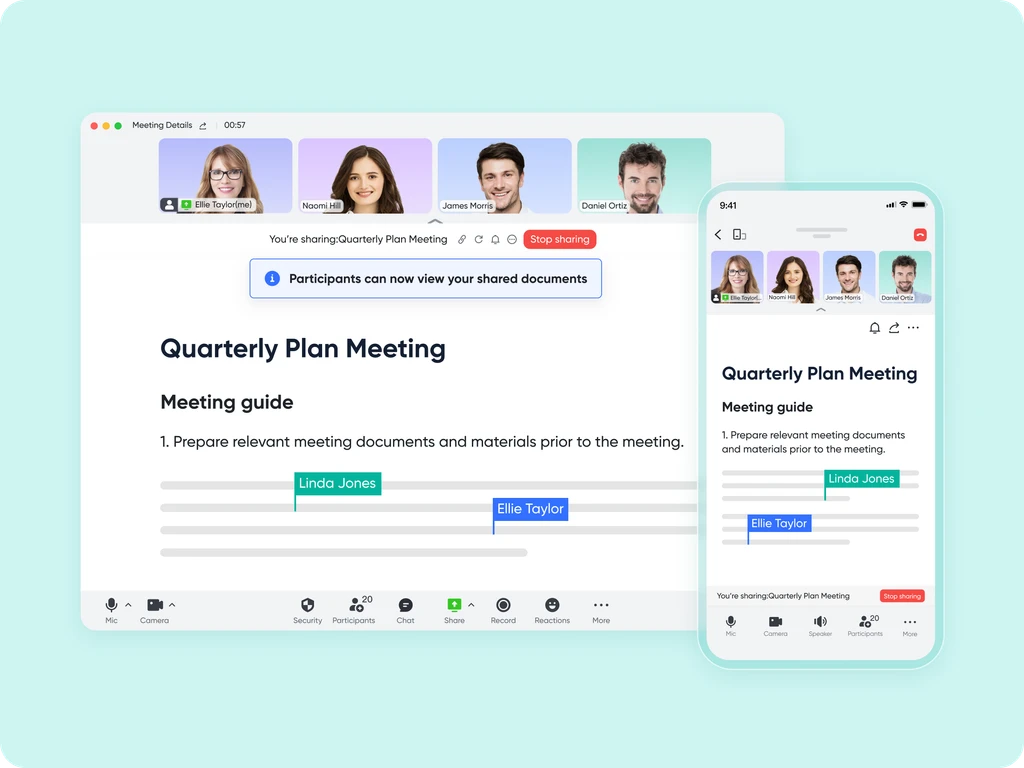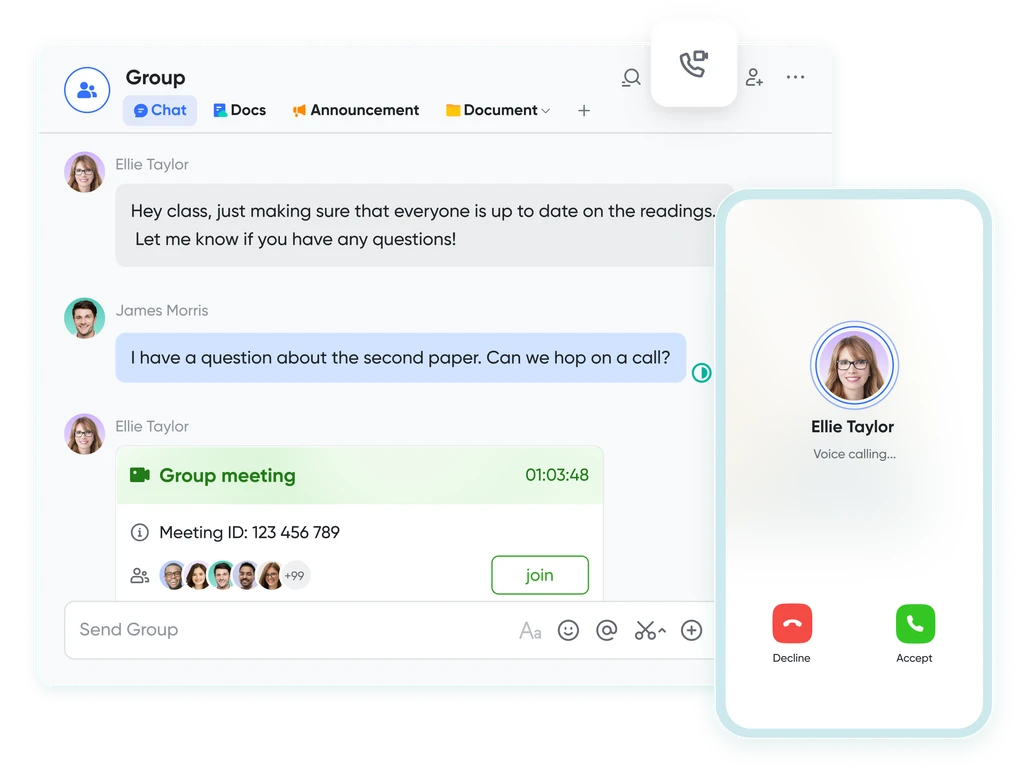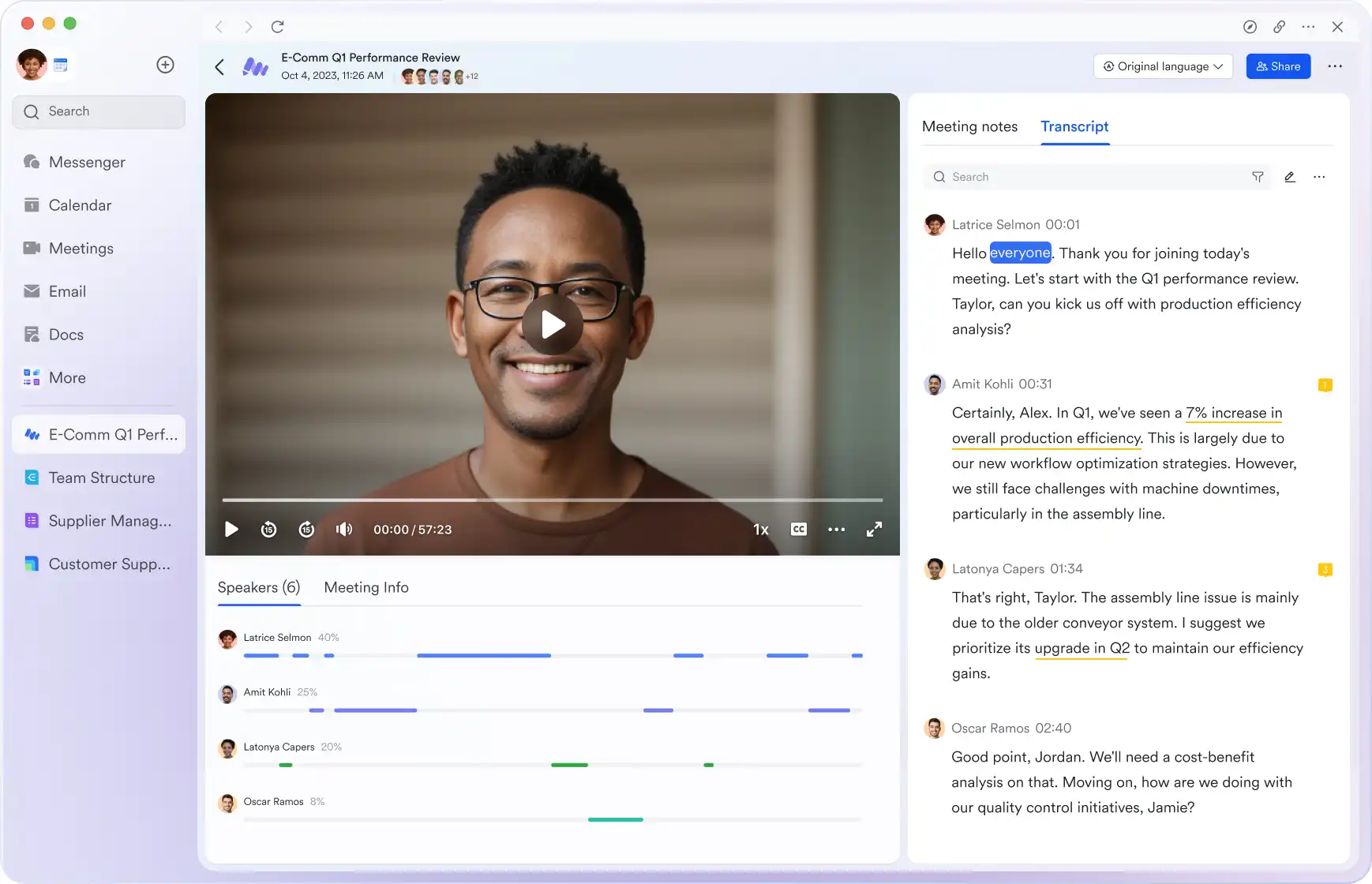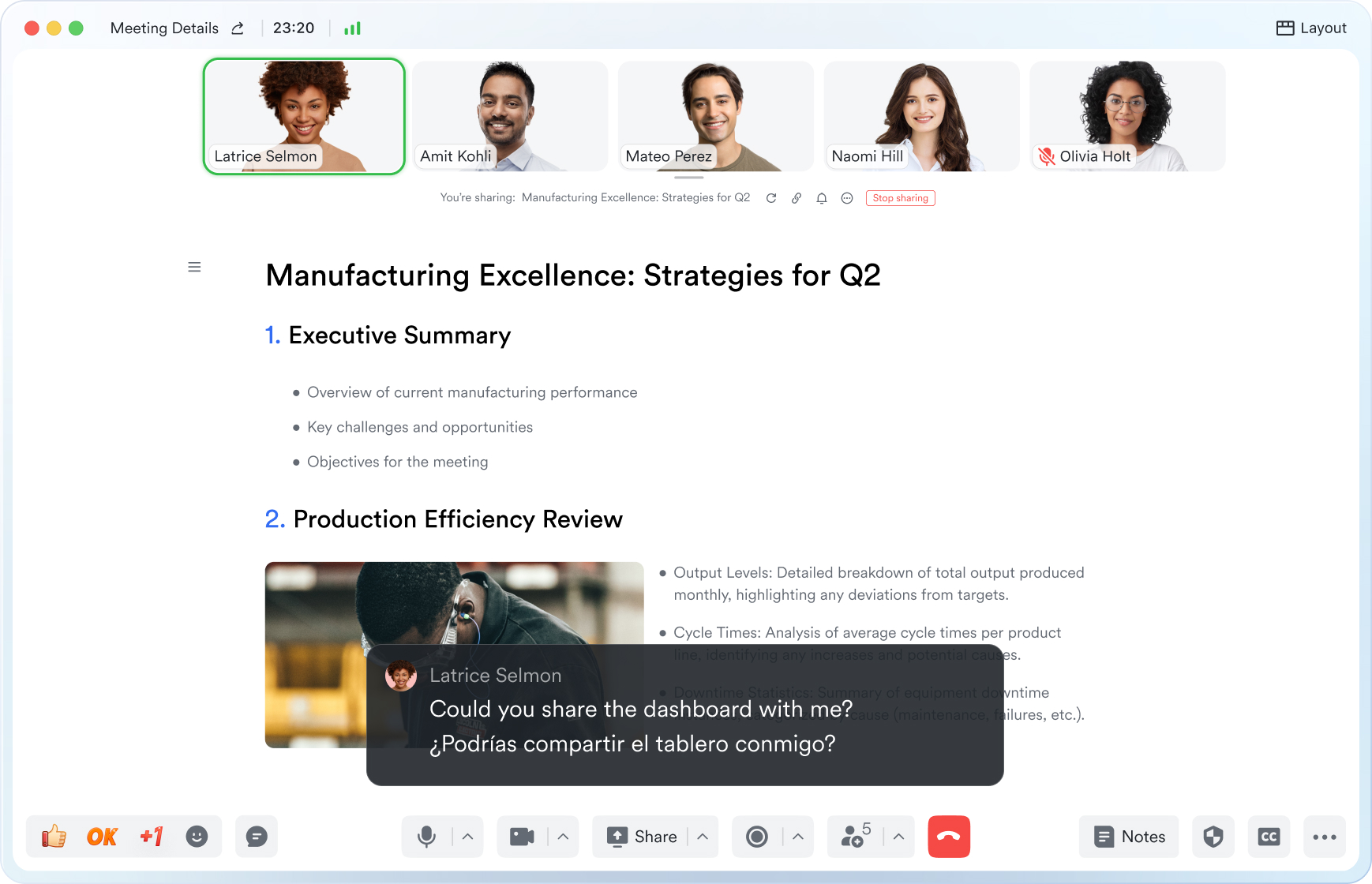User Research Meeting
This guide will walk you through the essential elements of use user research meeting to keep your attendees aligned and engaged.
Try Lark for Free
User research is a crucial aspect of product development and can significantly impact the success of a business. User research meetings provide a platform for the entire team to gain insights into user behavior, preferences, and needs. In this article, we will delve into the intricacies of hosting a successful user research meeting in 2024, covering its key elements, goals, dos and don’ts, examples, and much more.
Use Lark Meetings to turn meetings into true collaborative experiences.
What is a user research meeting?
A user research meeting is a forum where stakeholders come together to discuss and analyze user feedback, observations, and test results. This type of meeting is essential for understanding users' needs, pain points, and behaviors. It enables product teams to make informed decisions, validate assumptions, and refine the user experience. By emphasizing direct interaction with users, a user research meeting provides critical insights that drive product improvement and innovation.
Goals of user research meeting
The primary goal of a user research meeting is to gather actionable insights that contribute to the enhancement of a product or service. This includes understanding user expectations, identifying usability issues, and uncovering opportunities for improvement. Furthermore, the meeting aims to align stakeholders towards a user-centric mindset, fostering empathy and understanding of the end users.
Who should attend user research meetings?
User research meetings should ideally involve a diverse group of participants to ensure comprehensive insights and holistic decision-making. The key participants include:
-
Product Managers: Responsible for defining the product vision and strategy, product managers play a crucial role in synthesizing user research insights into actionable improvements.
-
Designers and UX Specialists: A deep understanding of user behavior and preferences is essential for designers to create intuitive and appealing user interfaces.
-
Developers and Engineers: Engineers bring technical expertise and are instrumental in understanding the feasibility of proposed design changes based on user feedback.
-
Stakeholders: Executives and other stakeholders should be part of the meeting to grasp the user-driven insights and align business goals with user needs.
Learn more about Lark x Meetings
Topics, agenda, and structure of user research meetings
Topics
- Understanding user pain points
- Exploring user needs and motivations
- Testing new features or prototypes
- Analyzing user behaviors
Agenda
- Introduction and goal setting
- Presenting user research findings
- Interactive discussions based on the findings
- Brainstorming and ideation
- Action planning and next steps
Structure
- Opening: Welcome and introduction of participants
- Presentation: Sharing user research findings and observations
- Discussion: Analyzing findings and seeking inputs from participants
- Brainstorming: Exploring possible solutions and improvements
- Conclusion: Recap of key takeaways and actionable steps
Learn more about Lark x Meetings
How often does a user research meeting occur?
User research meetings should ideally be held periodically, aligning with the product development lifecycle. This could range from weekly sessions for intense design sprints to monthly or quarterly meetings for broader research insights. The frequency ensures a continuous flow of user-driven insights and fosters a user-centric mindset throughout the organization.
Key differences between user research meetings and similar gatherings
While user research meetings share similarities with other collaborative sessions such as design reviews or brainstorming meetings, their primary distinction lies in their singular focus - the user. Unlike general brainstorming meetings, user research meetings center around user data and feedback, aiming to directly impact the user experience and product development.
Related:
Master the Art of Meeting Notes with Lark for Enhanced Collaboration | Lark Blog | Lark BlogLearn more about Lark x Meetings
Three practical examples of user research meetings
Example 1: inclusive user research meeting
Example 1: inclusive user research meeting
In a large-scale digital transformation project, the team conducted a user research meeting focused on inclusivity. By involving individuals from diverse backgrounds, including differently-abled users, the team gained perspectives that led to design enhancements catering to a broader audience.
Example 2: iterative prototype testing
Example 2: iterative prototype testing
A software development team conducted a user research meeting to gather feedback on an iterative prototype. The meeting revealed crucial usability issues and informed iterative improvements, resulting in a more intuitive and seamless user experience.
Example 3: feature prioritization workshop
Example 3: feature prioritization workshop
A product team organized a user research meeting to prioritize features based on user needs. Through collaborative discussions and analysis of user feedback, the team streamlined the product roadmap, focusing on the most impactful features.
Common pitfalls of user research meetings
When not conducted effectively, user research meetings may encounter the following pitfalls:
-
Biased Interpretation: Succumbing to preconceived notions or selective interpretation of data can lead to biased insights.
-
Lack of Follow-up: Without actionable follow-up steps, valuable insights gathered during the meeting may remain unutilized.
-
Underrepresentation: Failure to involve a diverse group of participants may result in limited perspectives and inadequate decision-making.
Learn more about Lark x Meetings
Dos and don’ts of user research meetings
| Do's | Don'ts |
|---|---|
| Invite a diverse group of participants | Disregard the importance of user feedback |
| Actively listen to user insights | Jump to conclusions without thorough discussions |
| Document meeting outcomes and action items | Overwhelm the meeting with excessive technicalities |
| Foster an open and inclusive discussion environment | Disregard feedback from underrepresented user groups |
What makes a virtual user research meeting successful?
In an increasingly digital landscape, virtual user research meetings necessitate a consistent focus on engagement and seamless collaboration. A successful virtual user research meeting entails:
- Leveraging innovative digital collaboration tools for interactive discussions and idea sharing.
- Ensuring clear communication and effective facilitation to maintain engagement and attentiveness.
- Providing a conducive virtual environment that allows participants to share insights comfortably.
Learn more about Lark x Meetings
Typical takeaways of the user research meeting
User research meetings typically yield the following key takeaways:
- Actionable insights and recommendations for product enhancement.
- Identified pain points and opportunities for improving the user experience.
- A roadmap for addressing usability issues and implementing user-driven improvements.
Questions to ask in the user research meeting
Asking targeted questions during a user research meeting can unearth invaluable insights. Some essential questions may include:
- What are the primary pain points encountered by users?
- What features or functionalities do users find most valuable or frustrating?
- How do users perceive our product in comparison to competitors?
- Are there specific trends or patterns in user behaviors that drive their interaction with our product?
- What improvements or changes would users prioritize in our product?
Learn more about Lark x Meetings
Conclusion
Hosting a successful user research meeting in 2024 requires meticulous planning, active participation, and a steadfast commitment to user-centricity. By leveraging these insights and experiences effectively, organizations can meaningfully enhance the usability and relevance of their products and services.
Learn more about Lark x Meetings
Use Lark Meetings to turn meetings into true collaborative experiences.
A Game Changer for User Research Meeting: Empower your team with Lark Meetings
In the fast-paced and dynamic world of modern business, effective communication and collaboration are crucial for success of User Research Meeting. Here we introduce Lark Meetings to serve as a centralized hub for all communication needs.
Transform your meetings into collaborative endeavors

Leverage the potency of in-call document sharing, intelligent meeting minutes, and mobile-optimized features to enhance productivity collaboratively, irrespective of your location or schedule.
Seamlessly collaborate in real-time, across any device

Share live documents instead of just screen views. Participants can navigate and edit simultaneously within the video call window, even while on the move.
Shift your focus to engagement, not note-taking

Lark Minutes automatically converts video meetings into transcripts, facilitating easy viewing, searching, and collaborative editing. Stay in the loop asynchronously, even if you can't attend the live meeting. Lark Minutes for meeting minutes support translation into 10+ different languages.
Break language barriers in communication

Lark Meetings provide real-time translation for subtitles, allowing individuals from diverse backgrounds to express themselves in their native languages. Ensure every voice is heard, regardless of geographical location. Live subtitles currently support translations from English, Chinese, and Japanese to 10+ different languages. See more translation feature in Lark.
Connect with larger audiences
Host dynamic online meetings and events accommodating up to 1,000 participants, with the flexibility of up to 50 breakout sessions for intimate group discussions within the larger meeting context. Try more Lark features for free.








